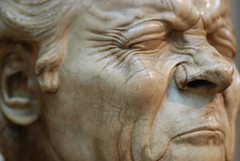 |
| Grahambones on flickr.com |
We've found these fellows usually make the most fanfare during hot weather. They can't really help it, it's just their nature. So what can we do to make summertime RVing as 'nose-comfortable" as possible? Here are a few tips:
Odor from black water comes from the naturally stinky nature of what we put down the pot. Some holding tank treatments deal with that by masking the odor with perfumes or other deodorants. Others deal with the smell by reasoning this way: Since the breakdown of the waste is what's causing the smell, stop the breakdown and you'll stop the smell. These "biocides" do just that: They kill all bacterial action in the holding tank, the wastes stop breaking down, and the odor, to some degree stops. How well these work in really killing the odor is rather subjective, and can certainly be affected by outdoor temperatures. The hotter it is, the worse the stink.
Some RVers tell us they don't use any sort of holding tank treatment at all. Almost universally among these we find that most thoroughly flush their black water holding tank every time they dump it, and few venture into hot climates. If you do chose to skip the treatments altogether, the consensus of RVers is to "get it out of there as quickly as you can, preferably in a week or less."
That's a tough assignment for some. Since it's not wise to dump a holding tank if it's less than three-quarters full, a rig with a large holding tank could go a LONG time between dumps. Our fifth-wheel's 40 gallon tank only required dumping every three weeks when we full-timed. On the other hand, since we were boondocking most of the time, we were pretty careful about how much water we used to flush. So, if you want to move-it-in move-it-out quickly, don't spare the flush water. Flush away to your heart's content and fill up that tank with water for a quicker release.
When it does come to treatments, we've lean toward the more "natural" kind, bacterial-enzyme treatments. We found them to be quite effective in keeping the odor down, and in keeping the tank free of build up. Ah, but when summer's warmth came, we did find some issues.
One foul smelling experience when the combination of heat and non-motion did "shut down" the bacterial action in our tank. That was bad! To get out of that problem we had to empty the tank and fill it completely with water and a large dose of baking soda. After 24 hours we emptied the tank, then started using it again with a fresh dose of bacterial-enzyme treatment. The odor was gone, and we were happily back in business.
Our experiences lead to warm weather holding tank tips: As we've already pointed out, the more often you dump, the happier you'll be. Here's the corollary: Keep moving! The more you stir up the contents of your holding tank (logically by driving) the less odor problems you can anticipate. Besides, the more you keep moving, the more of the country you'll see!
What about treating your gray water tank? Few RVers ever do much of anything about treating their gray tank. We recommend you abstain from pouring grease down the drain, but for the most part, a gray tank will give you few problems.

